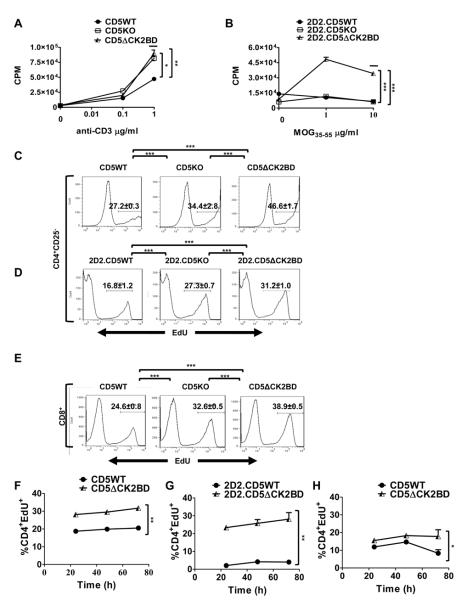FIGURE 5.
CD5-CK2 signaling pathway-deficient T-cells are resistant to development of anergy. Purified CD4+ T-cells were stimulated for 24 h with anti-CD3 or MOG35-55 peptide, rested for 72 h, and then re-stimulated for 48 h with anti-CD3 or MOG35-55 peptide. A and B, Frequency of CD4+ T-cells incorporating [3H]thymidine following 48 h re-stimulation with varying concentrations of anti-CD3 (A) or MOG35-55 peptide (B). Data ± SEM represent the average of 2 mice per group per experiment, n= 3 experiments. C and D, EdU incorporation by CD4+ T-cells restimulated with anti-CD3(C) or MOG35-55 peptide (D). Cells were pulse labeled with EdU after 48 h re-stimulation. E, EdU incorporation in CD8+ T-cells 48 h after re-stimulation with 1 μg/ml anti-CD3. F and G, EdU incorporation in co-cultures of F, CFSE-labeled CD5WT and unlabeled CD5ΔCK2BD CD4+ T-cells restimulated with anti-CD3 mAb or G, CFSE-labeled 2D2.CD5WT and unlabeled 2D2.ΔCK2BD CD4+T-cells restimulated with MOG35-55 for the indicated times. H, Effect of in vitro restimulation on in vivo primed T-cells. CD5WT mice and CD5ΔCK2BD mice were immunized with 150 μg MOG35-55 peptide in CFA, s.c. Seven days later CD4+ T-cells from spleens from both groups of mice were co-cultured in the presence of MOG35-55 peptide and proliferation was assessed by EdU incorporation at the indicated time points. Data ± SEM represent the average of 2-3 mice per group per experiment, n= at least 3 experiments. Bars above plots denote regions of statistical significance. *p<0.05, **p<0.01, ***p<0.001 with Student t test.

